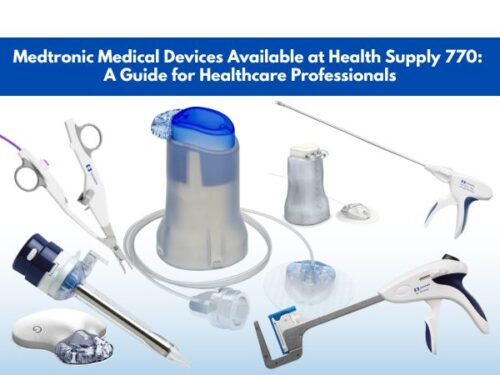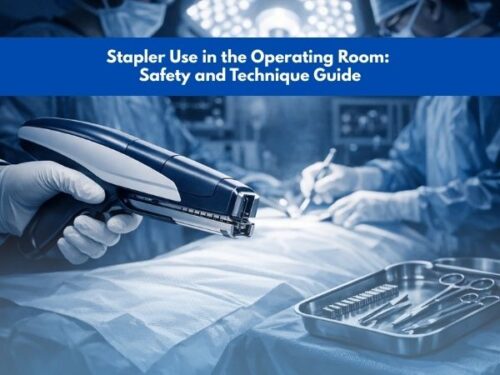What is a Laryngoscope Blade and What it is Used for?

When the need for a laryngoscopic procedure arises, it is necessary to easily access the tracheal tube for the purpose of conducting an examination as well as performing a surgical treatment. However, due to the posterior alignment of the epiglottis, it is difficult for the physician to visualize the glottis, larynx, or vocal cords which not only hinders the accurate detection of the disease state but also restricts the treatment techniques to work in full efficiency. Therefore, to solve these issues, laryngoscope blades have been designed and marketed which help in clarifying the tracheal view as well as assist in the operational procedures related to the trachea. Let us take a deeper look at what these laryngoscope blades are, which of their types are commercially available, and in which conditions they are employed.
What is a laryngoscope blade?
A laryngoscope blade is an examination tool applied to the windpipe with aim of taking a clear interior view. These stainless steel blades, though come in different shapes and sizes, two of these devices dominate the others. These commonly used commercial laryngoscope blades are the following:
- Macintosh laryngoscope blades
- Miller laryngoscope blades

A comparison of the curved Macintosh blade with the straight Miller blade
Macintosh blades
The Macintosh blade, named after the anesthetist Robert Reynolds Macintosh, is a curved examination device with an easy operation method. These blades are commonly employed in tonsillectomy i.e. surgical removal of tonsils.
Characteristic features of Macintosh laryngoscope blades
The Macintosh laryngoscope blades have the following characteristics:
- The Macintosh laryngoscope blade is easy to handle and uncomplicated to operate.
- These blades are prepared with polished stainless steel which renders them corrosion-proof.
- Macintosh blades are available as single-use devices but some versions are also available for multiple uses.
- The Macintosh laryngoscope blades are available in different sizes which makes it easy for the physician to choose the right device according to the requirement.
- Some of its models are affixed with tooth protection areas which decrease the chances of tooth damage while employment.
Available sizes of Macintosh laryngoscope blades
The Macintosh laryngoscope blades are available in sizes 0 to 4. Size 0 is used for the neonates while size 4 is for adult use.
| Sizes of Macintosh laryngoscope blades | Ideal patients |
| 0 | Neonates |
| 1 | Infants |
| 2 | Pediatric patients |
| 3 | Small adults |
| 4 | Large adults |

Different sizes of Macintosh laryngoscope blades
Miller blades
Miller blades are comparatively straighter in shape and specially designed to lift the epiglottis in order to obtain a clear view of the vocal cords. These laryngoscope blades have been named after their inventor, anesthesiologist Robert A. Miller. This type of blade is particularly helpful with pediatric patients.
Characteristic features of Miller laryngoscope blades
The Miller laryngoscope blades have the following characteristics:
- These laryngoscope blades are latex-free.
- The Miller blades are prepared of stainless steel with a 4 mm acrylic core.
- Different sizes of these blades are color-coded for quick identification.
- The sizes of Miller laryngoscope blades vary between the ranges of 00 to 4.
- Their single-use versions as well as the multiple-use versions are also available. A reusable handle is affixed to the original blade which enables the replacement of the blade after a single use.
- Their unique design, particularly the no-touch hook, provides safety against the transmission of infections.
- The Miller laryngoscope blades are durable, highly economical, as well as corrosion-resistant.
Available sizes of Miller laryngoscope blades
The Miller laryngoscope blades are available in sizes 00 to 4. Each size has a suitability based on the patient’s age group.
| Sizes of Miller laryngoscope blades | Ideal patients |
| 00 | Premature |
| 0 | Neonates |
| 1 | Infants |
| 2 | Pediatric patients |
| 3 | Small adults |
| 4 | Large adults |

Different sizes of Miller laryngoscope blades
Applications of laryngoscope blades
Both the Macintosh as well as Miller blades are employed for the following purposes:
- Laryngoscope blades are employed for the visualization of the larynx for the purpose of medical examination.
- These blades can also be utilized while conducting surgeries on the larynx or on the areas around the larynx.
- Laryngoscope blades are also of great importance while resuscitating a patient i.e. the process of restarting a patient’s breathing.
- The placement of an endotracheal tube (ETT) is also followed by the insertion of a laryngoscope blade into the trachea with the aim to make a way for the tube.
Risks associated with the use of laryngoscope blades
Both the Macintosh as well as the Miller laryngoscope blades are extremely useful in multiple medical procedures. Yet, some side effects have been found to be associated with them which are as follows:
- If not cleaned properly, the laryngoscope blades can result in the transmission of infection into the patient’s trachea. These pathogens can further seep into the bloodstream and can cause severe sepsis.
- In case of improper placement of the laryngoscope blade into the trachea, the soft tissues of the trachea can be ruptured which may result in bleeding.
- In some cases, the front teeth may also be damaged if too much pressure is applied while placing the laryngoscope blade.
Conclusion
Laryngoscope blades used in different examination methods as well as surgical procedures occupy a prime spot in the list of essential medical equipment. Both types of these blades i.e. Macintosh and Miller laryngoscope blades, though vary in design and shape owing to several improvements done in the past decades, have distinct characteristics as well as prominent uses. Hence, the laryngoscope blades are one of the much-needed medical items in hospitals.



















